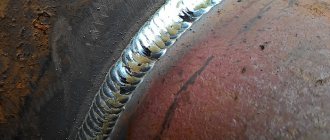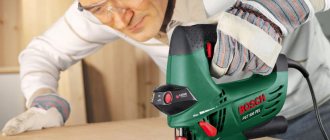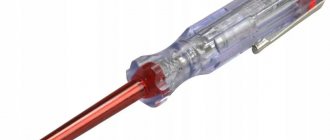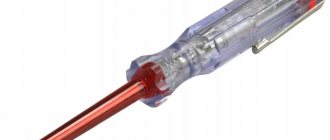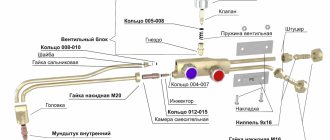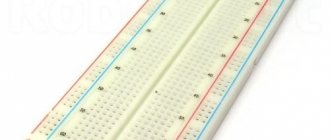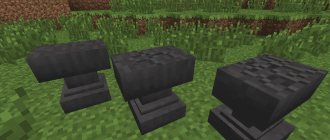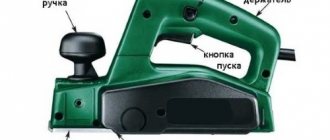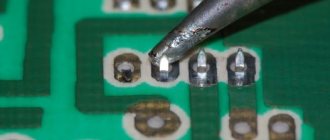The tool is fixed on a workbench or table, pressed with a clamp, and is completely safe and easy to use. In this article we will look at how to use a miter box, how to make a tool with your own hands and its types.
What is a miter box for baseboards
The unusual name of the carpentry tool “miter box” comes from the German word “Stoßlade”, which, literally translated, means tsulaga (press) for miter cutting. In common parlance, a miter box is a tray resembling an inverted letter “P” in shape with paired oblique slits in the side slats located at a certain angle to the central axis.
The size of the cut slots should allow the cutting tool, saw or hacksaw to move freely, but without lateral play.
The classic number of slots is six, three on each side: two for cutting at an angle of 45 degrees (left and right parts) and one for a right angle (some tool models have slots at an angle of 15, 30.60, and 135o or in 15o increments). With the help of such a device, a 45o angle is cut out of the baseboard for precise and beautiful connection of the baguette in the corners.
It is possible to accurately cut down the skirting board without various devices. There are time-tested technologies for this. However, this is difficult and only professionals with extensive experience can do it. For self-taught people, it is better to use a miter box for ceiling plinths, which allows you to get a perfectly accurate connecting angle easily and simply.
Let's cheat a little
In some places, the neatness of the joint of the baseboard is not important - for example, behind a tall cabinet. In this case, you can simplify your life by gluing the ceiling plinth and cutting out the corner after gluing. True, there is no need to talk about a clean cut and perfect joining of fragments - most likely, joining defects will have to be covered with putty of a suitable color.
It may be necessary to putty the joint even if the walls are not level enough. Here it is better to take care in advance about the simple profile of the skirting boards and their small width, as well as sufficient flexibility. Otherwise, it will be clearly visible that in some places the edging does not adhere to the wall/ceiling.
Special corner elements for PVC skirting boards will help to disguise sloppy corners. They can be simple or figured, matched to the color and texture of the ceiling edging.
For complex profiles, larger corner sections are specially produced that imitate stucco.
When using such corner elements, gluing the plinths to the ceiling in the corners requires straight cutting of the ends. For corners placed on top, the accuracy of cutting is not very important, but if the joining fragment is inserted between two planks, it is necessary to process their edges as carefully as possible.
In what cases is it used?
It is a mistake to think that the device was invented solely for cutting corners on a baguette. The must, on the contrary, came from other areas of carpentry in the decoration of walls and ceilings. This construction tool is actively used for:
- production of door frames;
- installation of door and window frames;
- production of glazing beads for fastening window glass;
- preparing strips for frames for photographs and paintings;
- cutting cable ducts;
- cutting corners at floor and ceiling plinths.
Using a miter box as a device for working with fillets allows you to file down the ends so that they touch at the corners without gaps.
Cutting methods
Cutting materials can be done either with or without a miter box. In the second case, it is quite problematic to achieve the ideal option.
Using a miter box
To cut, you need to firmly press the material with its entire surface to one of the side parts of the miter box. After work, minor errors such as nicks can be carefully removed using sandpaper.
Cutting without a miter box
There are times when miter boxes are not available. A ruler, pencil, sheet of paper, knife or jigsaw come to the rescue. If the surface of the material is large, then it is better to draw a cut line directly on it. Then draw a perpendicular to it using a square or sheet of paper. Equal segments are measured on each side of the angle. The distance between the corners is divided in half and the resulting point is connected to the vertex of the corner. Next, you can use a cutting tool.
Markings on the wall
You can trim the material using markings on the wall. Start the process from the inner corners. The frieze is applied to the corner of the wall and a straight line is drawn on the ceiling along the baguette. Next, draw a line over the adjacent adjacent plinth, cut at 90 degrees. A dot is placed at the intersection of the lines. It is alternately transferred to two friezes, from which they will make a corner. A straight line is drawn from this point to the nearest corner of the opposite side of the fillet. The excess part of the frieze is cut off with a knife. I do the same with the second baguette. The fillets are connected after trimming and adjustments are made as necessary.
Types of miter box
Miter boxes are classified by type according to three criteria:
- size;
- the material from which the instrument is made;
- designs.
Size
Based on the first feature, there are two standard sizes:
- standard. Designed for working with narrow parts: ceiling plinths, glazing beads, frame strips (for photos and paintings), etc.;
- big. The design of such devices does not differ from standard ones. The only difference is the length and width of the tool, as well as the height of the bars. The corners of the floor plinth, platbands, door frames, etc. are cut into it.
- wood;
- plastic;
- metal, mainly aluminum.
Material
On sale you can find miter boxes made of different materials:
Tree. Wooden models of the tool have good performance characteristics: ease of use and cutting accuracy, which, together with an affordable price, have made this type of device for cutting materials at a given angle the most widespread. Adding advantages to a tool made from boards is the ability to make a miter box for the baseboard with your own hands.
Structurally, wooden tools are made of 3 boards, one of which is the base, the other two are side planks with slots at different angles. They can be dismountable - fastened with self-tapping screws and non-dismountable - the connection of the planks to the base is adhesive with the addition of self-tapping screws for rigidity.
The disadvantages include a short service life - when working with a hacksaw or a saw, the teeth of the cutting tool file down the sides of the slot, as a result of which the groove increases in size. A lateral displacement of 1-2o appears, which immediately affects the quality of the baguette joint in the corners. Therefore, for professional carpenters, tool models made from other materials are preferable. But for doing housework, this is an ideal option.
Plastic. Tools made of plastic, mainly PVC, have a budget price (polyurethane ones are more expensive), a variety of standard sizes and low weight. They are a one-piece construction with slots on the sides. It is used exclusively at home, since the service life is even shorter than that of its wooden counterpart: the slots increase in size much faster, exceeding the permissible standard.
Metal. Miter boxes made of steel or aluminum are tools for professionals. These are durable and easy-to-use products with high cutting precision. The price matches the quality: it is very high.
Design
According to the design features, miter boxes are divided into:
- to simple ones or, as they are also called, ordinary ones. They are templates with predetermined cutting angles. The classic version has three pairs of grooves: for the right and left baguette at 45o and for a cross cut. In some models you can find up to 11 pairs of slots. When working with such a tool, it must be fixed on the workbench using a clamp. The second clamp secures the workpiece, from which you need to cut off a corner according to a given template. Often you have to work without clamps. In this case, the plinth and miter box are held with one hand, and the corner of the fillet is filed with the other. If you work in such conditions carefully and do not rush, you can saw off a corner with the same quality as when using fixing tools;
- rotary _ Such tools are better known as precision miter boxes. It consists of a rotating platform and a disk segment on which degrees are marked, which allows you to cut any angle. A number of models can also be tilted, which makes it possible to cut the part at the end in two planes at once (called universal). It is convenient to work with such a device for a small number of operations - manual sawing is still exhausting.
A miter box for working in two planes at once.
- electric . These are the same rotary tools, but with a circular saw. They are used mainly by professional builders for mass filing of corners, although such a mechanism is also found among household tools.
Carpentry Tool Dimensions
For practical work, the size and weight of the miter box itself, as well as the characteristics of the holding groove, are important. Household structures have a low weight, reaching 0.2-1.0 kg.
Such devices are very easy to work with, but cutting a large board will not work. Professional rotary models typically weigh up to 4 kg. Such miter boxes are stationary structures that require sufficient space.
Miter box groove dimensions
- For a board 3.5*3.5 cm. Small miter boxes have similar characteristics.
- Mid-level carpentry tools have grooves measuring 6.5 * 4.0 cm.
The largest values are for grooves of 9.0*5.5 cm, which can be found on large miter boxes. The length of the working part, as a rule, does not exceed 31 cm.
Principle and rules of working with the device
For many owners of an apartment or house who carry out renovations on their own, it is news that there are special devices for cutting the corners of a baguette. Therefore, they are poorly versed in how to use a miter box for baseboards.
The very principle of using the device is extremely simple. Take a baguette and fasten it in a miter box opposite the 45o slot in the same position as it will be glued to the wall. At the same time, it should protrude 1-2 cm beyond the boundaries of the zone in which the corner will be cut, which will make it possible to obtain a smooth, chip-free end. The workpiece is fixed with clamps, and in their absence, it is pressed to the base of the device by hand. There is a little trick here: it is more convenient to cut if the saw is located on the side of the working hand (the grooves in the tool allow this to be done) .
Knowledge of the operating principle does not guarantee accurate and beautiful connection of the baguette in the corners. You also need to know the basic rules of how to cut a ceiling plinth using a miter box.
- The cutting tool must match the material of the fillet. It is best to cut polystyrene foam with a knife with a replaceable blade. Plastic - with a knife, a hacksaw or a grinder with a diamond-coated cutting wheel. Wooden fillet - using a fine-tooth wood saw.
- Baguettes with relief or ornament must be combined according to the pattern.
- To avoid mistakes when determining the direction of the cut, you need to mark in advance with a pencil the line along which the saw will go. There is no need for special precision here: the main thing is to correctly indicate the chosen direction.
- You need to start cutting after checking the quality of fixation of the plinth in the tool: whether it is installed correctly; How securely is it fixed?
Rules for using the device
To cut a workpiece at a certain angle you need:
- Secure the part by pressing it to the working platform with clamps or clamps that are present on the base.
- Set the angle at which you want to cut. To do this, use a side graduated scale. The bracket with a hacksaw is moved and secured at the desired angle.
- Sawing the part.
When working, you need to be careful: often inexperienced craftsmen make mistakes when calculating angles, as a result of which the workpieces have to be thrown away.
Expert opinion Dmitry Konstantinovich Levin To saw ceramic elements, you will need to buy a special string. They are made from hard alloys with a special coating.
How to cut material
When cutting, it is extremely important not to mix up the sides. In order to correctly cut the material at an angle of 90 or 45 degrees using a miter box, it is secured in the body and then rested against the end wall.
And only then the material is sawed. If the tool is professional, then you can adjust the size down to the millimeter.
A template should be made for each section, taking into account a margin of 50 mm. Since the walls in rooms are not always smooth, before cutting the material you should check how they fit together.
The cut should be carried out as follows:
- mark the cut line with a pencil;
- place your product in the miter box body with the front side so that the cutting line mark looks like a continuation of the slot in the tool;
- Press the workpiece from the end of the body wall, insert a hacksaw into the slot, then cut the material according to the mark;
- insert the second blank with the other side into the slot;
- We clean out any unevenness using fine sandpaper.
How to cut an arbitrary angle
Sometimes the walls are not connected to each other at right angles, then the sawing will need to be adjusted. This is done in two ways:
- Using thick paper or a homemade cardboard template. If the plinth is hollow from the inside, it is unlikely to stay vertical. In this case, you will need a homemade corner in which the product is placed, just like in a miter box. The corner is placed on a pre-prepared stencil so that it matches the template, then the product is cut according to the marks.
- Make marks on the material using a pencil. Cut two products at an angle of 90 degrees, then attach them to the wall and mark the junction line. Find the point of contact between the skirting boards, then transfer the markings to the material and make a cut.
Sawing off corners of floor plinths (internal and external)
The rules for sawing off the inner corner of a floor plinth are as follows:
- the miter box must be placed on the table parallel to itself;
- press the product to the side opposite to you;
- place the right plinth on the right, and the left one on the left, respectively, cut from the opposite side;
- align both parts of the plinth, you will end up with an internal corner, the top of which is located away from you.
As for sawing off the outer corner , here you need to adhere to the following rules:
- We place the miter box on the table parallel to ourselves, as in the previous case;
- press the baseboard on your side;
- we install the right product on the right, the left one - on the contrary, we bring it to a diagonally located line, sawing is carried out from the bottom up;
- Connect the parts, we get an outer corner with the vertex towards you.
Which miter box to choose in the store
When choosing a device, you need to focus on its functionality (at what angle and on what planes to cut the workpiece) and the volume of work performed. Simple, U-shaped tools are purchased if you need to install floor or ceiling plinths on your own; rotary tools are intended for craftsmen. If you need a complex cut in 2 planes, then a non-professional will have to buy a rotary miter box.
When purchasing, you should pay attention to the following characteristics:
- the material from which the device is made;
- base width;
- wall thickness;
- the presence of a cutting tool in the kit;
- number of slots (the more, the better);
- the presence of clamps (fasteners);
- How free is the saw?
You can buy a simple device without a hacksaw for 87-820 rubles. The cost of a rotary miter box starts from 1300 rubles. It is difficult to say how much an electric tool costs, even approximately. The price difference is huge. You can buy a miter saw for either 6 thousand rubles or 25 thousand rubles.
Among the brands stand out:
"Fit 41255". The model is made of durable plastic. There are slots at angles of 22.5, 45, 90 and 135o for vertical cutting and 45o for bevel sawing. The price of the tool starts from 335 rubles.
"Stanley1-20-112." Material: one-piece impact-resistant plastic. Cuts can be made at an angle of 22.5, 45 and 90o vertically and 45o horizontally. Allows you to make very precise cuts. The cost starts from 770 rubles.
"Zubr15375-75". Made from impact-resistant technical thermoplastic resin (ABC plastic), which allows you to maintain the size of the slot for a long time. You can buy it for 220-340 rubles.
"Fit Pro 41321". Professional rotary miter box. The frame can be steel, aluminum or plastic. A saw is included in the kit. Costs from 3500 rubles. up to 6700 rub.
Subtleties of choice
When purchasing a miter box, there are several technical points to consider. First of all, you need to pay attention to the size of the angles that this device is capable of forming. Classic devices operate in a rather narrow range and are equipped with slots corresponding to angles of 45, 90 and, less commonly, 60 degrees. This device is well suited for cutting skirting boards, slats, platbands or bars, the installation of which will be carried out on a surface with traditional geometric shapes. If a miter box is purchased for professional activities or for finishing non-standard premises, then it is better to opt for a rotary or electric model, the range of angle formation in which reaches 135 degrees.
The second selection criterion is the material used to make the tool. Thus, the purchase of metal models is technically justified only for professional activities; in other cases, it is better not to overpay and purchase a simple plastic or wooden miter box. When purchasing rotary models, it is recommended to pay attention to the density of the hacksaw blade. It should not be too elastic and bend freely. The requirement for metal rigidity is due to the fact that when soft blades act on the material, the edges of the cuts become uneven and begin to crumble during the cutting process.
Another important point when buying a miter box is the choice of manufacturer. So, when purchasing a manual model, you can pay attention to brands such as Zubr, Topex and Fit, and when choosing an electric model, you can pay attention to Interskol and Einhell. These models have performed well and are most often recommended by professionals.
To learn how to join skirting boards, see the following video.
There is nothing complicated in the process of installing ceiling plinths. Here it is only important to decide on the appropriate glue for the material. However, corners in the room can make our work much more difficult. They are both internal and external.
Of course, by resorting to the use of special accessories, you can save considerable time. This does not require special skills, only accuracy in performing the work. Another option for assembling the ill-fated corner would be to cut the edges of the plinth at an angle. Having the ideal geometry of the room, the question of how to correctly cut the plinth at an angle equal to half a straight line is more than solvable. Numerous videos on the Internet will also help you figure out how to cut a plinth .
Is it possible and how to do it yourself?
You can postpone a trip to a retail outlet to buy a device if you have the following on hand:
- 3 boards 30-50 cm long. One of them is 15-20 cm wide (base), two for making sides 30-50 mm each (a high side makes it difficult to work with a saw);
- furniture screws with hexagon heads;
- glue;
- cutting tools for woodworking (saw, hacksaw);
- clamps - these can be a vice or clamps;
- a set of hexagonal furniture keys (confirmations);
- electric drill or screwdriver with a set of drills;
- ruler;
- protractor;
- corner;
- construction pencil (marker);
- sandpaper P120.
From the given set of materials and tools, it is not difficult to make a simple device for adjusting the ends of the baguette when connecting them in the corners.
The step-by-step action plan is as follows:
- the bottom of the base and sides are sanded with sandpaper;
- the base is attached in a vice or clamp to the workbench;
- a side board is applied to the side of the base (covers the side edge);
- using measuring instruments, the angle formed by two boards is checked - it should be 90o;
- in 3-4 places the side strip and the base are drilled with a screwdriver (the drill should be 1-2 mm thinner than the self-tapping screws);
- PVA glue is applied to the edge of the base (any type of glue for wooden products can be used);
- the side is screwed to the base with furniture screws;
- a similar operation is carried out on the other side of the miter box;
- Using a ruler, protractor and pencil, marks are made for the slots. There should be 3 of them on each side. One pair for cutting parts at a right angle, the other two pairs at an angle of 45o, for the left and right baguette. The location of the grooves can be arbitrary, but it is more convenient to work if there is a groove in the middle of the device for an angle of 90o, and on the sides at an equal distance for angles of 45o;
- You need to make cuts with a saw all the way to the base.
Using a homemade device will save the family budget with good quality corner cutting.
How to make a miter box from wood at home
Making a miter box with your own hands is not particularly difficult. How to make a miter box with your own hands, see the video below.
How to make a box
First you need to select the material for making the box. Coniferous planks up to 2 cm thick are ideal for these purposes. Plywood should have a smooth surface and even corners. For greater productivity, it is recommended to make the box no more than 15 cm wide. The sides are fixed to the bottom using self-tapping screws. Edges are placed on the lower part.
Marking cutting locations
It is impossible to make a high-quality miter box with your own hands for the baseboard without clear slits. Accurate marking is required along lines parallel to each other, located at the same distance. The slits are made using a hacksaw and sandpaper.
How to cut a baseboard using a miter box
There is nothing complicated in the instructions on how to cut a ceiling plinth using a miter box.
1. The plinth is placed in the miter box with its face up, so that the plane in contact with the ceiling lies on the base, and the second is pressed against the side of the device. In this case, the bar should protrude 1-2 cm beyond the cutting line, which is clearly visible in the photo.
2. The fillet is pressed forcefully against the device, and a cutting tool (saw, hacksaw) is inserted into the slot. By the way, in the second photo the location of the plinth is more convenient for left-handed people. For those who are used to sawing with their right hand, you just need to switch to the other side or turn the miter box with the plinth 180o.
3. The end is cut.
4. The second plinth is cut in a mirror image.
5. The cut areas are sanded with fine paper using a cutting tool with a tooth. Naturally, after the knife the grinding operation is not carried out.
You can see in the photo how to properly cut the fillet ends for the internal and external corners.
Safety precautions
When working with a hacksaw using a miter box, it is advisable to use thick gloves and safety glasses to prevent sawdust from getting into your eyes.
The tool must be fixed on the desktop.
If it is not equipped with any clamps, the workpiece is held in the required position by hand.
To do this, at a safe distance from the groove with the inserted saw, the thumb rests on the material being cut, presses it against the side of the miter box, and the remaining fingers clasp this same side.
When starting a cut, the saw should be inserted into the grooves at least to the height of the teeth.
Marking with a canvas is carried out with slow, even movements, which will protect the master from jumping out of the groove.
Is there a difference in technology for floor and ceiling plinths?
At first glance, there is no difference in cutting corners for ceiling and floor plinths. Indeed, there are none if we are only talking about how to make a corner with a miter box - the sawing technology is the same.
Otherwise, there are and they concern methods for determining the length of scraps for joining in corners. So, at the top, when cutting the end, the upper part of the bar is shortened, at the bottom, on the contrary, the lower part. When joining the plinth at the outer corner, the ceiling plinth increases in size at the top, and the floor plinth at the base.
What you need to know about the miter box?
To perform a specific type of work, something like a miter box is often made, where only one seat is modeled for the task.
Such options include a tool, for example, for cutting soap.
Convenience of work increases with marking, and the cut can be not only straight, but also curly.
To work with specific types of miter boxes, a special hacksaw is required.
However, this does not mean that you cannot use any other sawing tool.
The difference is that in the second case the cut will not be as smooth and clean.
As for the special saw supplied with the miter box, it has a backing that prevents the blade from bending and at the same time acts as a depth limiter.
You can replace it with a hand hacksaw or a bow saw with a medium-sized tooth.
Tips for cutting corners using a miter box
Let's supplement the instructions on how to use a miter box with a few simple rules, the implementation of which allows you to correctly cut the corner of the baseboard.
- When starting work, you should not panic if after the first cuts the ends do not fit together perfectly. You need to be prepared for the fact that you will have to adjust the first strips of the plinth more than once.
- Beginners often get confused about the sizes of corner strips. To prevent this from happening, the measurement is done as follows: the length of the fillet for the internal corner starts directly from the adjacent wall, for the external corner - from the edge of the corner plus the width of the baseboard, since the upper corner will protrude into the room.
- Before placing fillets on glue, even if you are absolutely sure of the correct cut, you need to check how accurate the joint is. To do this, attach the touching ends to each other directly in the corner.
- Builders have not yet learned how to make an angle exactly 90o. Therefore, there will always be small gaps. They can be sealed with gypsum putty or sealant.
- If the walls are not blocked (they stand vertically), the moldings can be adjusted at the bottom, even if the angle is acute or obtuse.
